RETRACTED: Investigation and Analysis of Translation Ability Research on the Psychological Obstacles of College Students in English Learning under the Background of Wireless Network Communication
Abstract
The experience of learning a series of English languages is not only a series of knowledge acquisition but also a process that enables students to have a continuous psychological transformation. The development of English learning psychology determines the final effect of English learning. Translation ability is an indispensable ability in English learning. The development of translation ability has a profound impact on English learning psychology. Domestic and foreign scholars have conducted related investigations on English translation ability and college students’ English learning psychology, but these studies have not established a connection between English translation ability and psychological barriers and have not clearly solved the problem. There is also a large gap in research methods. Theory. This research is aimed at exploring the interaction between translation ability and psychological barriers in English learning under the background of wireless network communication and promoting the improvement of college students’ comprehensive English ability. This article first discusses the content of English translation and expounds the types of learning disabilities and the specific manifestations of learning disabilities. Then, through the questionnaire survey method, it analyzes the translation ability and English learning psychology of the current college students in our country. Finally, the Apriori data association algorithm is used to explain the relationship between them, and specific solutions are proposed based on the survey results. Studies have shown that 72.6% of students have poor English translation skills, and 69.4% of students have psychological obstacles in English learning. Apriori = 0.89, close to 1, indicating that college students’ English translation ability is closely related to psychological barriers.
1. Introduction
As the momentum of socialization intensifies, as the common language of global communication, it will certainly become a hot topic of study in various other countries, and the number of English professional exams such as cet-4 and cet-6, ielts that are being given, and toefl is increasing. English learning in our country is accompanied by the whole process of our learning, but the actual learning effect of English is not ideal; Chinese college students’ oral English and the overall translation ability are big weaknesses. The English translation ability is closely related to the actual English learning effect. The lower the English learning effect, the more likely the students are to have psychological barriers. Once psychological barriers occur, the vicious circle of English learning will appear. In view of the actual situation of English learning in college students in China, the low translation ability is a common problem, and the psychological barrier of English learning has become a common phenomenon. Therefore, the research in this paper is of great significance to explore the interrelationship between translation ability and college students’ psychological barriers in English learning, promote the improvement of translation ability, and further help college students overcome the psychological barriers in English learning.
Translation ability is an important criterion to measure students’ English quality and an important factor to cultivate English majors. At this moment, scholars at home and abroad have been conducting a series of investigating and researching on the English interpretive ability of the university students, and some of their achievements have been made. In literature [1], the author gives an overview of the development of professional English from the perspective of English translation major and then explains the current situation of Chinese college students’ English translation ability by means of data analysis and proposes solutions from three aspects: teaching system, teacher-student relationship model, and interest. In literature [2], the author points out the problems existing in the teaching mode of English translation in China under the Internet environment and advocates that the teaching mode of English translation should be reformed with the help of the Internet concept. In the literature [3], the author, first of all, from the angle of the relationship between language and translation of English translation plays an important part in English language acquisition and then translates the English ability to ascend the ultimate goal of determined for level 3 English ability, with the help of “equivalent hierarchical model” that puts forward the college English level 3 translation methodology and quality evaluation standard, and expounds the university English translation of the principle of the specific weights of evaluation criteria and assign points; in the literature [4, 5], the author, from the perspective of cultural ecology, first expounds the concrete connotation of cultural ecology and then clears the significance of the cultural ecology of English translation; the author through a series of research proves that under the background of cultural ecology, the English translation is affected by cultural differences in environment that show different forms, English translation, and extreme flexibility [6].
The emergence of English learning psychological barrier not only hinders the development of students’ learning potential but also adversely affects their overall psychological development. In order to overcome the adverse effects of psychological barriers in English learning, scholars at home and abroad have conducted a series of studies. In the literature [7], the author takes the special group of art vocational college students as the research object, analyzes the current situation of college students′ English learning, and points out that the main psychological obstacle of college students′ English learning is the lack of interest and confidence in learning. Finally, from the perspective of interest and emotional communication, he proposes relevant solutions to these problems. In [8–10], the authors investigated the Guangxi National College non-English major students as the investigation object, using the methods of questionnaire and interview, the key national regions of college students’ English learning interest, motivation, attitude, and the concentration of the main factors that affect performance results in their English learning which has carried on the investigation and analysis, moreover also focuses on the university English four, six levels of tests on the main effect of students’ psychological. Finally, based on the actual situation of students’ English learning, this paper puts forward some relevant solutions. In literature [11], the authors in Wuhan University of Science and Technology are the main research object, through questionnaire survey and the interview way, and the linear computation is introduced into the empirical study; this paper analyzes the college students’ psychological barriers of English study and the relationship between the existing English teaching pattern, which proved that the teaching model reforms in the positive role of psychological obstacles to overcome.
To sum up, existing studies have carried out relevant studies on college students’ English translation ability and psychological barriers of English learning, but few studies have proved the correlation between the two. In this respect, there is still a certain theoretical gap in this aspect [12]. In order to fill the gap in theory and promote the improvement of college students’ comprehensive English ability [13, 14], this paper first discusses the components of English interpreters and has an explanation of the types of learning disabilities and the specific manifestations of learning disabilities. An analysis of the translation ability and English learning mindsets of current Chinese college students is then presented by means of a survey questionnaire. Finally, it explains the mutual relationship between the two by means of the Apriori data association algorithm and puts forward specific solutions according to the survey results [15, 16]. The research in this paper is not only conducive to the rapid improvement of students’ comprehensive English ability but also lays a theoretical foundation for future related researches.
2. Method
2.1. Translation Ability under the Background of Wireless Network Communication
2.1.1. Introduction to Wireless Sensor Network
The wireless sensor network is composed of a large number of cheap micro sensor nodes deployed in the monitoring area, which are formed through wireless communication.
Into a multihop self-organizing network. The sensor network realizes the three functions of data collection, processing, and transmission. The map has many types of sensors that detect vibration, electromagnetism, that temperature, humidity, noise, light intensity, in pressure, and various phenomena of the surrounding environment such as soil composition, size, and the speed and direction of flow of moving substances. Potential application areas can be summarized as military, aviation, explosion protection, disaster relief, environment, medical treatment, health care, household, industry, commerce, and other fields. As depicted in Figure 1, it is a prototype application for a wireless sensor network. After being provided with various types of information, the nodes of a large-scale wireless sensor of network can easily obtain a large amount of information about the target object by connecting with a gateway to the cascade ethernet.
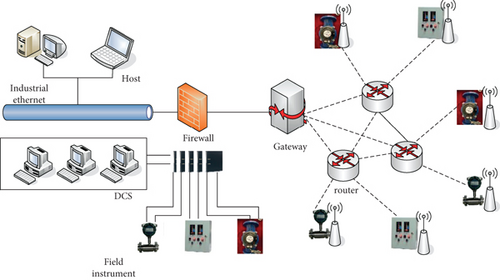
2.1.2. Common Network Topologies for Wireless Sensor Networks
The wireless network topology is usually divided into cluster network, mesh network, hybrid network (layered network), and other network topologies, as shown in Figure 2.
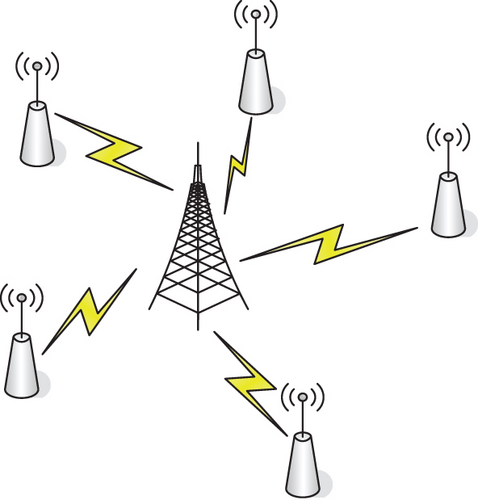
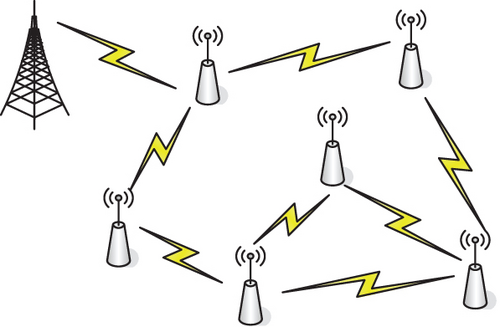
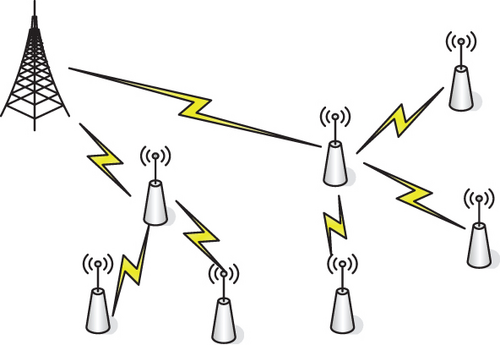
The clustered network topology is a single-hop structure. All terminal wireless sensor network nodes directly communicate with the base station node in two-way without establishing a connection with each other. The base station node can be a computer, dedicated control device, or other gateway that communicates with high data rate devices, and each terminal node in the network can also be different according to application requirements. This structure consumes relatively large energy for the wireless sensor network topology, and the wireless sensor network nodes are relatively close to each other.
A meshed and network topology is a multihop fabric. All wireless sensor grid nodes in the network can be communicating with one another directly. Through a certain algorithm, the network selects one or more routes for multihop data transmission. Since each sensor node can have multiple paths to reach the base station node, it has a strong fault repair capability. The system replaces single-hop transmission with multihop, which reduces the power required for each sensor node to send data.
The hierarchical network topology is a more typical one in hybrid networks. The signal nodes form into independent clusters by a method specified by the base station or by a self-organized approach. Each one of them is controlled by a cluster head composed of nodes in the cluster and consolidates and then processes the data collected with the cluster and forwards it to the base point.
2.1.3. Wireless Communication Energy Consumption Model
The power supply capacity of sensor nodes is limited, and energy consumption is the primary consideration in the design of WSN routing protocols. Therefore, studying wireless channel energy consumption models can help design routing algorithms. This paper uses the wireless communication energy consumption model when calculating the energy consumption of sensor nodes. In the wireless channel, the signal strength is inversely proportional to the power exponent of the distance between the transmitter and the receiver.
Among them, Eelec is the energy consumption of the transmitting circuit and the receiving circuit when transmitting and receiving data per unit bit. εamp is the unit power consumption of the amplifier, and d is the distance for data transmission. It can be seen from formula (1) that energy consumption is proportional to the transmission distance, and the longer the data transmission distance, the greater the energy consumption.
2.2. English Translation Ability and Psychological Barriers to Learning
With the acceleration of the process of internationalization, the communication between China and other countries in the world is also being strengthened, and a large number of professional English translators are urgently needed. English translation ability is based on basic English knowledge, English cultural background, translation skills, and other multilevel knowledge, so it can be said that the level of English translation ability can directly reflect the level of English learning [17]. Dyspraxia of the learning mind is dyspraxia of the student’s school that needs to be climbed. The causes of learning psychological disorder are complex, including both external and internal factors. Psychological barriers in English learning refer to students’ psychological fear and fear of English for some reason in English learning, and it is difficult to achieve satisfactory results in English learning under such psychological effects [18–20]. Generally speaking, those with higher English translation ability have a higher overall English learning level, which means that they are less likely to suffer from psychological barriers in English learning. From this point of view, there is a mutual relationship between English translation ability and English learning disorder, which needs to be further verified in the following paragraphs.
There are generally four main typologies of common impairments to learning: first, there are motivation and disorder. As early as 1972, Gardner, a foreign scholar, divided motivation to learn a foreign language into two types: integrative motivation and instrumental motivation. Integration motivation refers to language learning in the need of interpersonal communication. This kind of motivation is to obtain spiritual satisfaction through language learning so as to realize harmonious integration between individuals and others. Instrumental motivation refers to that the purpose of learners’ learning is to obtain certain economic benefits or benefits, which is obviously utilitarian, such as obtaining job opportunities or economic benefits by means of examinations, which are all instrumental motivations. If too much emphasis is placed on instrumental motivation, once the ultimate goal is achieved, the motivation to learn will be lost, which will lead to motivation obstacles. Second, mood disorders. From the perspective of cognitive psychology, the learning subject’s absorption of knowledge is closely related to the emotional identity of the learning subject. The higher the students’ sense of achievement in English learning is, the higher their emotional identity will be. On the contrary, students often frustrated in English learning will produce anxiety and humiliation psychology, so the emotional awareness of English will be very low; this situation is prone to emotional filtering. Once emotional filtering occurs, learning behaviors become mechanical and meaningless, and knowledge learned cannot be internalized and understood, which is why the difficulty of English learning is greatly increased. Therefore, people usually regard affective disorder as a direct resistance to English learning. Third, cognitive disorder. Cognitive mode refers to the unique way in which people organize and analyze certain information or experience. It is a psychological concept. Scholars generally agree to divide cognition into field independence and field dependence. Since the 1970s, foreign researchers began to associate cognitive style with foreign language learning and studied the effects of two cognitive styles on foreign language learning, but they have not reached a consensus. Available researched data have demonstrated that the field-dependent cognitive style has a counter-productive effect on foreign language learning. Students within this cognitive style lack initiative in English education and are passive learners. In general, “field-dependent” students have lower school performance than “field-dependent” in English.
2.3. Manifestations of College Students’ Psychological Barriers in English Learning
The manifestation of college students’ English learning psychological disorder is extremely complex, which is embodied in the following aspects: first, they show a certain degree of anxiety and fear towards English. English course runs through the whole process of students’ education and is also a required course. In addition to its status as a global language, English has always been in the key position of students’ learning. The level of English score directly affects the overall level of students. Students with low English score for a long time will suffer from burnout of English and anxiety and panic in the face of English, which is anxiety psychological disorder. Whenever such psychological barriers are formed, students will lose confidence in English learning and experience dispersion, so that the vicious situation of English learning will continue to expand. Compared with students without mental disorders, students with anxiety disorder will gradually become afraid of English, especially in public. So I gradually lost my heart to learn English. Second, seek fast English unintentionally. Since many students have difficulties in English acquisition, a large proportion of these students try to find shortcuts in English learning based on the pursuit of success, trying to be able to achieve fast results in its learning at the least cost, while accumulating and mastering English at the least of their knowledge. We regard this psychological barrier as a quick psychological barrier in English learning; third, they show a dislike for English. As mentioned above, many students have a fear of English. Driven by this psychological state, in the long run, students will have an aversion to English from the bottom of their hearts, thus losing interest in learning English. In this case, students will appear to avoid English deliberately, which is harmful to English learning without benefit; this is called the aversion psychological disorder. Third, inversion. The reverse psychology is the highest level of English learning disorder, which means there is a great degree of resistance to English learning. In this state of conflict, students try to destroy the environment of English learning, hindering the normal conduct of English teaching activities. As a result, they often deliberately disrupt the normal order of English classes. The main manifestation of this state is to play devil’s advocate.
2.4. Apriori Data Association Algorithm
In the formula, c and w represent error rate and data loss probability, respectively. Adding these two data into the algorithm can realize in-depth investigation and analysis of college students’ English psychological barrier and translation ability. Generally, Apriori is set to represent the correlation between different data, and the correlation value is usually between 0 and 1. The closer the value is to 1, the higher the correlation between different data types will be, while the closer the value is to 0, the lower the correlation between different data types will be.
2.5. Wireless Network Resource Allocation Based on Differential Collaborative Learning Model
2.5.1. Spectrum Allocation Model in Multicellular Networks
In wireless communication systems, according to different multiple access technologies, such as frequency division (FD), time division (TD), or code division (CD), an available wireless spectrum is divided into a series of discrete noninterference channels. Set for users to use, denoted as f1, f2, ⋯. For a cellular wireless network with N cells, the static spectrum allocation problem can be modeled by the following matrices: channel demand matrix D (demand), interference constraint matrix C (constraint), and channel allocation matrix A (allocation).
Assuming that there are N cells in the cellular network, the definition of each matrix is as follows:
Among them, di(i = 1, 2, ⋯, N) represents the channel demand of the ith cell.
Among them, Cij indicates the minimum frequency interval required for the channels allocated to cell i and cell j to not cause interference; diagonal elements indicate Cij the minimum interval between any set of channels allocated to the same cell, that is, the same cell interference constraint CSC.
Among them, aki = 1 indicates that channel k is allocated to cell i, and aki = 0 indicates that channel k is not allocated to cell i.
2.5.2. Differential Collaborative Learning Model
The teaching and learning algorithm (TLBO) is an optimization algorithm proposed by R.V.Rao and V.D.Kalyyankar in 2010 through a learning model that simulates teacher teaching and students learn from each other in the process of human learning. The two main implementation steps of “teaching” and “learning” are adopted to improve the learning level of students. In the teaching and learning algorithm, all students are equivalent to the individuals in the evolutionary algorithm, a class is a population, and the individual with the best performance in the class is called the teacher.
Among them, and , respectively, represent the learning level of the ith student before and after the teacher’s teaching; TF = round[1 + rand(0, 1)] is the teaching factor, usually taking the value 1 or 2, and ri = rand is the learning rate.
Among them, F(Si) is the knowledge level of the student si, and F(Sj) is the knowledge level of the student.
In the process of implementing the “teaching” of the basic teaching and learning algorithm, each student learns by comparing the difference between the average knowledge level of the entire student in the class, and all students use the same difference value strategy to adjust. In this way, all students can easily and quickly move closer to the teacher, losing the diversity of students and falling into a local optimum. In the process of “learning,” students randomly select another student and adjust themselves by comparing the differences between themselves and that student. For low-dimensional and simple optimization problems, the basic teaching algorithm has high accuracy and fast convergence speed. But for some complex optimization problems, its global search ability is poor, and it is easy to fall into the local optimum. The channel allocation problem itself is a complex combinatorial optimization problem, which can be equivalent to a permutation problem. Therefore, this paper proposes a collaborative learning model based on a teaching algorithm. Aiming at the particularity of the channel allocation problem, it draws on the idea of a differential algorithm and proposes a solution to the spectrum distributing the “teaching” and “learning” strategies of the problem, and after students improve their learning level, introduce the “teacher self-learning” strategy to strengthen the algorithm’s local search ability, thereby increasing the global search ability of the entire class group.
2.5.3. Improved Students’ “Learning” Stage
In the stage of mutual learning among students, each student improves his knowledge level by communicating and learning with other students in the class. The learning process is as follows:
where V is a randomly generated 1 × N binary vector.
In the improved method for students to learn from each other, in step 2 and step 3, the unallocated cells are randomly arranged, and then, the newly generated individual students are inserted sequentially to obtain the new individual students after learning. The purpose of joining this random strategy is to increase the diversity among individuals in the entire class, avoid the algorithm from falling into the local optimum, and improve the algorithm’s global search ability.
3. Experiment
3.1. Investigation and Analysis Experiment
In order to investigate the relationship between college students’ English translation ability and English learning disorder, this paper conducts relevant investigation and analysis experiments through questionnaires and literature collection. The experiment in this paper is mainly divided into the following steps.
The first step is a questionnaire survey on college students’ English translation ability and English learning psychology. The questionnaire consists of two parts: the study psychology part and the translation ability part. To ensure the accuracy of the research results, this paper selected 600 sophomore students from a university to participate in the questionnaire survey. The content of the questionnaire in the section of translation ability involves the comprehensive aspects of translation theory, skills, comprehension ability, and interpretation ability. Students make choices according to their actual situation within a specified time. Through this questionnaire survey, we can have a better understanding of the current situation of college students’ translation and conduct targeted analysis and sorting. There are 30 questions in the psychological part of learning, which are composed of the following three parts. The second part is a survey on the social psychology of English learning, mainly including English learning environment, problems and obstacles in English learning, and students’ English learning status. The third part is the analysis and investigation of the psychological effect of English major examinations on college students, through the three parts of the survey to fully grasp the students’ learning English psychological state.
The second step is the data analysis of the questionnaire survey. In this paper, a total of 600 questionnaires were distributed and 589 valid questionnaires were collected. After the questionnaire survey, SPSS was used to conduct statistical analysis of the survey data, and Excel was used to draw relevant data charts to facilitate the analysis of the survey results. Finally, in order to verify the accuracy of data results, a certain number of students should be selected for relevant return visits.
The third step is the comparative analysis of original data and questionnaire data. In this paper, in a way to ensure the preciseness and authority of the experiment, we also used the relevant English learning websites, mainly the major interpreted websites, whose browsing data were the original data, in addition to the field questionnaire results. The size of the original value is proportional to people’s dependence on the translated site. After the data statistics, the original data, the survey data of English translation ability, and the survey data of English learning psychology were compared, and the correlation between each data was found by the Apriori data association algorithm, and relevant conclusions were drawn on this basis. The specific original data are shown in Table 1. The data in the table are the results of the author’s investigation and arrangement.
| Year | Page views (hundred million) | Proportion of English-related websites | Year-on-year growth |
|---|---|---|---|
| 2013 | 1.79 | 37.14% | / |
| 2014 | 1.98 | 39.29% | 3.17% |
| 2015 | 2.05 | 40.17% | 3.62% |
| 2016 | 2.17 | 40.40% | 3.74% |
| 2017 | 2.24 | 41.14% | 3.75% |
| 2018 | 2.26 | 42.61% | 3.62% |
| 2019 | 2.46 | 42.99% | 3.79% |
- ∗Data were collected from questionnaires and documents.
The fourth step is to obtain the current authoritative views on English translation ability and English learning psychological barriers based on the relevant conclusions of the previous step and by means of expert interviews. Based on the existing research data, this paper puts forward some relevant strategies to solve the problem of college English translation shortage and learning psychological disorder.
3.2. A Survey of the English Barriers of College Students through the Questionnaire
3.2.1. Survey of Interest in English
As shown in Figure 3, among the 589 students, 36 were “very interested” in English, accounting for 6.1%, and 193 were “relatively interested,” accounting for 32.7%, thinking that they were “average, not very interested.” There are 235 students, accounting for 39.8%. 134 people were “not interested at all” in English, accounting for 22.7%.
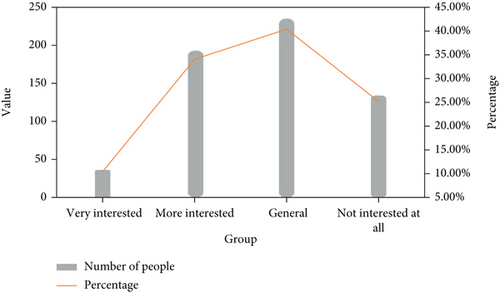
3.2.2. A Survey on Whether English Will Be Useful in Future Work
As shown in Figure 4, there are 71 students who think that English will be “useless at all” in the future, accounting for 12%. There are 110 students who think “sometimes use some but not a lot,” accounting for 18.6%. A total of 245 students thought it “more useful, but not very complicated,” accounting for 41.5%. There are 163 students who think “very useful,” accounting for 27.6%.
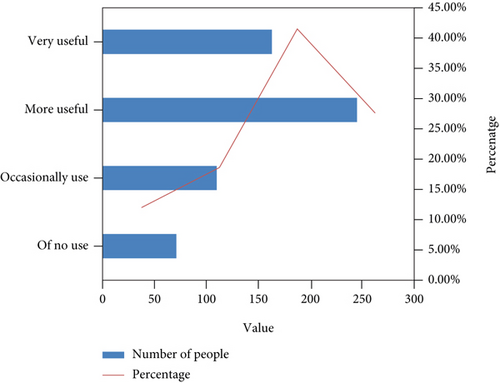
3.2.3. Investigations on Students’ Most Obstacles in English Translation and Grammar
As shown in Figure 5, there are 314 students, accounting for 53.3%, who believe that “not proficient in vocabulary and grammar” is the most impeded in English translation. There were 171 students who felt “very poor translation skills, thinking hard, racking their brains, and babbling, but they couldn’t translate, but had to give up,” accounting for 171 students, accounting for 29%. There are 102 students who think “I feel good about myself and can basically cope with translators,” accounting for 17.3%. There are 2 students who think that their writing ability is “very good and can basically be done easily,” accounting for 0.03%.
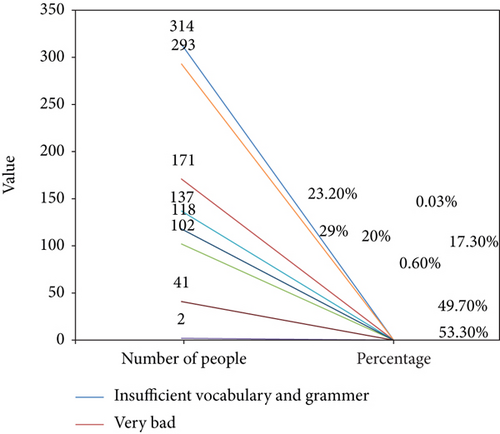
Statistics show that 137 students, accounting for 23.2%, feel “very difficult, such as various tenses, sentence components, voice, and subject-subordinate compound sentences, which are not easy to understand and too difficult.” The number of students who felt “a bit difficult, simpler ones are easier to understand, but some clauses and non-predicate verbs are more difficult to understand” is 293, accounting for 49.7%. There are 118 students who feel that “it’s not difficult. As long as you listen to the lecture carefully and do a little bit of review after class, you can basically understand it.” There are 118 students, accounting for 20%. There are 41 students who think that “as long as you work hard, grammar is not difficult to learn, and that it is mainly difficult to find excuses for your laziness,” accounting for 0.6%.
3.2.4. Investigation of Students’ English Classroom Learning and English Ability
As illustrated in Table 2, 236 or 40% of the students thought that “time is good, time lags, and if the content is in an engaging way, the teach can concentrate, otherwise not.” There are 184 students who think “not very capable, although the teacher speaks very well, but their basic knowledge is poor, and the lessons are laborious, and they tend to get distracted if they don’t understand,” accounting for 31.2%. There are 114 students who think “No, the content of the textbooks are practical, and the teachers are also very good, but they don’t want to learn and don’t bother to work hard,” accounting for 19.3%. The number of students who think “can listen carefully, the teacher speaks wonderfully and fascinatingly, and I have a good foundation, so it sounds very enjoyable” is 46, accounting for 7%. There are 167 students who think that their learning ability is “unsatisfactory, due to their poor foundation and laziness, so they cannot study on their own”, accounting for 28.3%. There are 253 students who think that their learning ability is “not good enough, and Bai Ji can learn without the help of a teacher, but it is very reluctant,” accounting for 42.9%. There are 130 students who think that they can learn independently with the help of dictionaries, grammar books, or reference materials on the base, accounting for 22%. 38 students think that the learning ability is “very good, I have a set of my own methods for learning English, and I can study on my own with the help of reference books,” accounting for 6.4%. There are 150 students who think that “there is no perseverance at all, the foundation is relatively poor, and they will directly answer the questions when encountering problems, and will not continue to think,” accounting for 25.4%. There are 280 students who think “not ideal enough, although they will use their brains to think, but if they can’t think of it, they will check the answer with other students,” accounting for 47.5%. There are 142 students who think “it’s okay, I will work hard to solve it independently as much as possible, and if I still don’t understand after considerable effort, then ask the teacher or other classmates”, accounting for 24.1%. There are 17 students who think “very good, Bai Ji will contact the teacher or look up the information for serious analysis until I understand it,” accounting for 2.8%.
| Can the classroom focus on listening | Number of people | Percentage | Language learning ability | Number of people | Percentage | English learning perseverance | Number of people | Percentage |
|---|---|---|---|---|---|---|---|---|
| Time difference | 236 | 40% | Unsatisfactory learning ability | 167 | 28.30% | No perseverance at all | 150 | 25.40% |
| If you do not understand, you will lose your mind | 184 | 31.20% | Not good enough | 253 | 42.90% | Not ideal | 280 | 47.50% |
| Too lazy to work hard | 114 | 19.30% | Independent study | 130 | 22% | Is acceptable | 142 | 24.10% |
| Fascinating, I have a good foundation | 46 | 7% | Fully self-taught | 38 | 6.40% | That is good | 17 | 2.80% |
3.2.5. Investigation of Students’ Extracurricular and In-Class English Learning Exchanges
As shown in Table 3, there are 167 students who think that “the foundation is poor, and a lot of what the teacher said in the classroom has not been understood, and they don’t even want to read it after class,” accounting for 28.3%. “After finishing the homework, they are only reviewing the content learned in the textbook. After all, admission to higher education depends on exams.” There are 262 students, accounting for 44.4%. “After finishing the homework, sometimes they would appropriately read some extracurricular English reading materials or listen to some English recordings.” There were 135 students, accounting for 22.9%. “First complete the homework, and then be able to plan the appropriate amount of listening, speaking, reading, and writing training”. There are 16 students, accounting for 2.7%. There are 189 students who think “there is no English environment at all,” accounting for 32%. There are 193 students who think the English learning environment is “not ideal,” accounting for 32.7%. There are 171 students who think the English learning environment is “okay,” accounting for 29%. 27 students think that the English learning environment is “very good,” accounting for 4.5%. The statistical results show that there are 172 students who “never talk to classmates, have poor English foundation, have no interest, and don’t want to learn at all,” accounting for 29.2%. There are 279 students who communicate “very little, with a poor foundation, and do not want to disturb others, but only occasionally ask others for advice,” accounting for 47.3%. There are 120 students who think that “everyone has similar grades, all get along, and when there is a problem, they communicate with each other and help each other,” accounting for 20.3%. “I have better grades than them, I have strong self-learning ability, and often help them” is 9 students, accounting for 1.5%.
| English learning in spare time | Number of people | Percentage | English learning environment | Number of people | Percentage | Do students communicate frequently | Number of people | Percentage |
|---|---|---|---|---|---|---|---|---|
| Do not want to watch it after class | 167 | 28.3% | No English environment at all | 189 | 32% | Never talk to classmates | 172 | 29.2% |
| Just review the content learned in the textbook | 262 | 44.4% | Not ideal | 193 | 32.7% | Rarely | 279 | 47.3% |
| Read some extracurricular English books appropriately | 135 | 22.9% | Is acceptable | 171 | 29% | If there is a problem, we will communicate | 120 | 20.3% |
| Plan appropriate listening, speaking, reading, and writing training | 16 | 2.7% | That is good | 27 | 4.5% | Often help them | 9 | 1.5% |
3.2.6. Investigation of Teacher-Student Interaction and Influence in English Class
The statistical results show that the number of students who think “basically all are full, no interaction, no passion, so I never actively participate” is 162, accounting for 27.5%. There are 215 students who think that “because most of the students are unwilling to learn, so the teacher is also desperate. Just talk by yourself and listen to them.” There are 215 students, accounting for 36.5%. There are 178 students who think “teachers speak more, students have fewer opportunities to answer and practice, and are not very interested in this kind of English class,” accounting for 30.2%. There are 34 students who think that “it is basically teacher-student interaction, teachers speak intensively, students practice more, combine lectures and exercises, and the effect is particularly good,” accounting for 5.7%.
As shown in Table 4, there are 145 students who think that “I will like English if the teacher’s lectures are funny and humorous, otherwise they have no interest at all,” accounting for 24.6%. There are 193 students who think that “I like English because they have a great influence, the teachers are good in teaching, and have affinity. Otherwise, I won’t have much interest,” accounting for 32.7%. There are 153 students who think that “If the teacher is not ideal, I will study as usual, but if the teacher is good, the interest will be improved,”, accounting for 25.9%. There are 98 students who think “no effect, no matter which teacher teaches, I will continue to study,” accounting for 16.6%.
| Teacher-student interaction in English class | Number of people | Percentage | Teachers of English have an impact on students learning English | Number of people | Percentage |
|---|---|---|---|---|---|
| No interaction | 162 | 27.5% | Particularly big impact | 145 | 24.6% |
| Most students refuse to learn | 215 | 36.5% | Greater impact | 193 | 32.7% |
| There are fewer opportunities for students to answer and rehearse | 178 | 30.2% | Some influence | 153 | 25.9% |
| Teacher-student interaction, the effect is very good | 34 | 5.7% | No effect | 98 | 16.6% |
4. Discussion
4.1. Analysis of the Survey Results of College Students’ Translation Ability
With the help of SPSS statistical analysis, the following survey data about the translation ability of college students are obtained. The specific data are shown in Tables 5 and 6 and Figure 6. The data in the chart is the result of the author’s experimental investigation.
| Translation skills | Strong | General | Weaker |
|---|---|---|---|
| Proportion | 1.2% | 26.2% | 72.6% |
- ∗Data were collected from questionnaires and documents.
| Specific performance | Number | Proportion |
|---|---|---|
| Lack of translation skills | 159 | 26.99% |
| Poor interpretation skills | 182 | 30.90% |
| Poor translation skills | 121 | 20.54% |
- ∗Data were collected from questionnaires and documents.

According to the data in Table 5, among the 589 students who participated in the questionnaire survey, only 1.2% of them had strong English translation ability. 26.2% of college students have average English translation ability. Most of the students have poor English translation skills, accounting for 72.6% of the respondents. Generally speaking, college students are generally weak in English translation. The data in Table 6 show that the weakness of college students’ translation ability is manifested in different aspects, including interpretation, translation, translation skills, and comprehension ability. The data in Figure 6 shows that there are various reasons for the weak English translation ability of Chinese college students. Among the students who express their weak translation ability, 41.27% believe that the low translation ability is closely related to the importance attached by teachers to English. 23.17% of the students think that the lack of English translation skills is the main reason for their low translation ability. 21.86% of the students think that their low English ability is caused by their poor command of English knowledge. 13.70% of the students blamed other reasons for the poor translation ability. Through the above survey, we can draw the following conclusions about the translation ability of college students: first, it is a common phenomenon that college students’ English translation ability is weak, and very few college students have strong English translation ability; second, the reasons for the weak English translation ability of college students mainly include the low attention of teachers, the lack of translation skills, and the weak foundation of knowledge. In addition, the data in Table 1 also show that the browsing times of English translation software are on the rise in recent years, which indicates that college students are weak in translation ability and highly dependent on English translation software. In view of the above conclusions, this paper puts forward the following suggestions for improving the translation ability of college students.
4.1.1. Teachers Should Pay More Attention to English Translation Ability
According to the survey data in Figure 6, the main reason for the low English translation ability of college students is that college teachers do not pay enough attention to this aspect. Therefore, in order to effectively improve students’ English translation ability, English teachers must strengthen the teaching of English translation in the future English teaching. Not only should the teaching of translation skills be strengthened but also efforts should be made to build a systematic English translation training to guide students to participate in it. Not only that, in order to enhance students’ interest in English learning, promote the continuous improvement of students’ English translation ability, English teachers should help students to establish an English translation interest group, strengthen the cooperation and mutual assistance between students, and constantly promote the improvement of their own translation ability in the exchange of students; moreover, teachers can also break the time and space limitation of English translation with the help of the existing information exchange technology. For example, the WeChat group of English translation learning is established to guide students to actively discuss English translation issues in the WeChat group. The establishment of the WeChat group makes it convenient for teachers to solve difficult problems in translation for students at any time and place and promotes the teaching of English translation to be more targeted. Finally, teachers can guide students to establish a learning plan for English translation and help them form good study habits as early as possible. To sum up, as long as English teachers pay enough attention to English translation and adopt all-round strategies to provide positive guidance to college students’ English translation, they can effectively improve their English translation ability.
4.1.2. College Students Themselves Should Attach Great Importance to the Cultivation and Improvement of English Translation Ability
Students themselves are the decisive internal reason for the improvement of English translation ability. The above survey results indicate that the reasons for the weak English translation ability of college students are also the lack of translation skills and the weak grasp of basic knowledge. In order to fundamentally change this phenomenon, college students must start from themselves, overcome their own negative factors that hinder English translation, and strive to improve their English translation ability through their own exploration and summary. First of all, in the daily learning of English, college students can collect all kinds of materials related to English translation through the Internet, outline the key knowledge, and systematically study and understand the knowledge. Secondly, students should work out an English translation learning plan according to their own needs and combine it with the weak links of English translation, so as to carry out targeted translation training. Finally, the improvement of English translation ability is based on the premise of solid basic knowledge, so college students should strive to strengthen the study of basic knowledge. In this way, vocabulary shortage and grammatical errors in English translation can be effectively avoided.
4.2. Investigation and Analysis of College Students’ Psychological Barriers in English Learning
With the help of SPSS statistical analysis, the following survey data about college students’ translation ability are obtained. The specific data are shown in Figures 7 and 8, which are the results of the author’s experimental investigation.
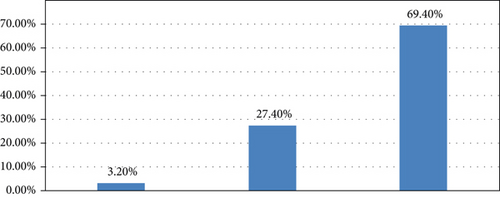
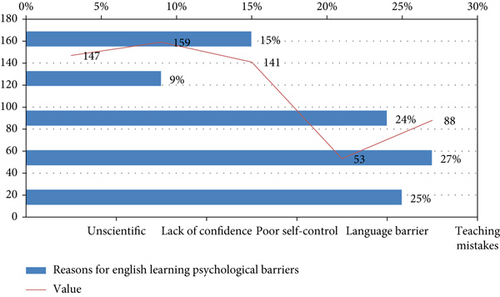
As shown in Figure 7, only 3.20% of college students who participated in the survey did not have English learning mental disorder, 27.4% had moderate English learning mental disorder, and 69.4% had severe English learning mental disorder. The data in Figure 8 show that there are many factors causing psychological barriers among college students, including unscientific learning methods, lack of learning confidence, poor self-control, language barriers, and teaching mistakes. In view of the above survey results, this paper proposes the following specific strategies to solve college students’ psychological barriers in English learning.
4.2.1. To Change the Roles of Teachers and Students and Stimulate Students’ Interest in Learning
As can be seen from the data in Figure 8, college students’ self-control is generally worse than their self-confidence in English learning, which is mainly due to their lack of internal driving force in English learning. Interest is the best internal driving force in learning, which can effectively stimulate students’ confidence and initiative in learning English. To maximize stimulate students’ interest in learning English, English teachers must implement the transformation of traditional role, a series of effective measures: firstly, English teachers should create a harmonious and interesting English learning atmosphere, break the limitation of book teaching, and guide students with breakthrough point closely related to the student’s words titled in English learning; secondly, teachers should break the traditional authority status and communicate with students on an equal footing in daily English teaching.
4.2.2. Strive to Eliminate the Emotional Barriers That Exist in College Students’ English Learning
Affective disorder is an important component of English learning psychological disorder, and the elimination of affective disorder plays a decisive role in the reduction and elimination of English learning psychological disorder. First of all, teachers should strive to build a good English learning atmosphere, guide students to communicate in English actively, and take certain measures to encourage them when necessary. Under such circumstances, students’ pressure and shyness in learning English will be greatly reduced, and their confidence in English learning will be effectively improved in the long run. Secondly, teachers should guide students to participate in extracurricular English training and expand their horizon of English learning to all aspects of daily life, such as daily English communication and watching English movies, which are conducive to the improvement of students’ overall English level. The higher the students’ English level, the lower the probability of English learning disorder. When students’ English level reaches a certain level, their sense of shyness and inferiority in English learning will disappear, these emotional barriers are alleviated, and their psychological barriers in English learning will be gradually eliminated.
4.2.3. To Reshape Students’ English Learning Motivation
The results of the questionnaire survey and interview in this paper show that most college students learn English for the “certificate motivation,” such as the current cet-4 and cet-6. This kind of motivation brings certain pressure to college students’ English learning. Once the ultimate motivation goal cannot be achieved, it is easy to produce the psychological barrier of English learning. To reduce the possibility of the psychological barriers to produce, must work hard to realize the transformation of students’ English learning motivation, change certificate motivation for communicative motivation, teachers and schools should let students’ awareness to English their cognitive window of the world, and English learning is beneficial to help students better to the world, is an important tool to realize own exchanges with the outside world, and is not the purpose of certain achievements. As long as students are clearly aware of this problem, the motivation of learning English will be able to change and strive to improve the practical application of English language ability.
4.3. Comparative Analysis of English Translation Ability and Psychological Disorders
In order to explore the relationship between English translation ability and English mental disorder, it is necessary to make a comparative analysis of the investigation on English translation ability and mental disorder. Through the data comparison, we can get the following comparison data graph. The specific data is shown in Figure 9. The data in the graph is the result of the author’s experimental arrangement.
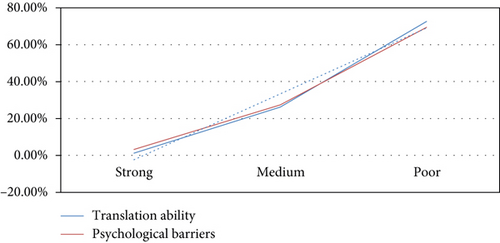
From the data in Figure 9, we can see that the data lines of the survey of psychological disorders and English translation ability basically coincide, which indicates that there is a close correlation between the two. In addition, the Apriori data association algorithm mentioned above is used to calculate the correlation between the two survey data, and the final result is Apriori = 0.89, with the value closer to 1. The results show that there is a close relationship between college students’ English translation ability and their psychological disorder. Therefore, in order to effectively promote the improvement of the overall English level of college students, it is necessary to take into account both of them and to improve the English learning level of college students by virtue of the mutual relationship between English translation ability and learning psychological barriers.
4.4. Psychological Assistance Intervention
4.4.1. Comparative Study of Experimental Group A, Experimental Group B, and Control Group before and after the Test
After the experiment, the paired-sample t-test was performed on the three groups of subjects to compare the differences between the pre- and posttests. The results are shown in Table 7 and Figures 10 and 11. From the statistical results in Table 7, it can be seen that before and after hypnosis intervention, the mental health factor scores and total scores of experimental group A are compared with the scores before the experiment. There are significant differences except for the compulsive factor (P > 0.05). P < 0.05, among which the total score of interpersonal relationship and anxiety reached extremely significant differences (P < 0.01), indicating that the mental health status of the subjects after the hypnosis group psychological counseling was significantly improved compared with that before the experiment.
| Item | Pretest | Posttest | T | P |
|---|---|---|---|---|
| Somatization | 1.58 ± 0.35 | 1.23 ± 0.23 | 3.075 | 0.011 ∗ |
| Force | 2.08 ± 0.48 | 1.89 ± 0.22 | 1. 498 | 0.162 |
| People | 2.39 ± 0.37 | 1.47 ± 0.25 | 7.364 | 0.000 ∗∗ |
| Anxiety | 2.53 ± 0.37 | 1.28 ± 0.23 | 10.502 | 0.000 ∗∗ |
| Paranoid | 1.85 ± 0.44 | 1.48 ± 0.27 | 2.538 | 0.028 ∗ |
| Other | 1.67 ± 0.38 | 1.30 ± 0.23 | 2.916 | 0.014 ∗ |
| Total score | 180.33 ± 15.56 | 129.75 ± 10.82 | 1 2.239 | 0.000 ∗∗ |
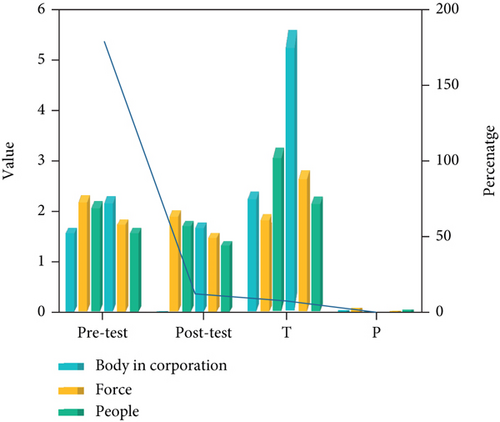
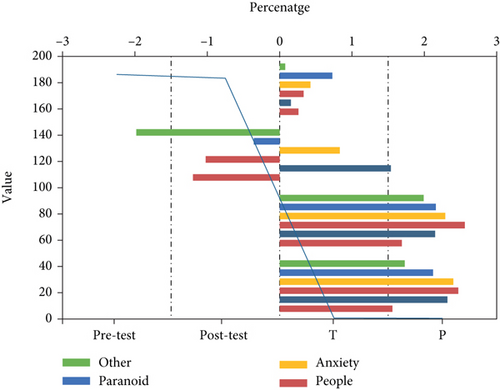
From the statistical results in Figure 10, it can be seen that there are extremely significant differences in the total score, interpersonal, anxiety factor, and the previous test in the experimental group B (P < 0.01). There are also significant differences in somatization, paranoia, and several other factors. Significant difference was reached, but no significant difference was not reached under compulsion (P > 0.05). In general, it shows that after general awareness level intervention, the mental health of the subjects has also been significantly improved.
From the statistical results shown in Figure 11, it can be seen that the statistical results of the control group show that there is no significant difference in the changes in the factor scores and total scores of the subjects before and after the experiment (P > 0.05).
4.4.2. Comparative Study of Experimental Group A, Experimental Group B, and Control Group before and after the Follow-Up Test
Two months after the end of the experiment, paired-sample t-tests were performed on the three groups of subjects to compare the differences before and after the test. The results are shown in Figures 12 and 13 and Table 8. From the statistical results in Figure 12, it can be seen that there is a significant difference (P < 0.05) except for compulsive and psychotic factors (P > 0.05) when comparing prehypnosis group psychological intervention and posttracking tests. Among them, interpersonal relationship, anxiety factors, and total score reached extremely significant differences (P < 0.01), indicating that after two months, the effect of hypnotic intervention was basically maintained, and the long-term effect was very good.
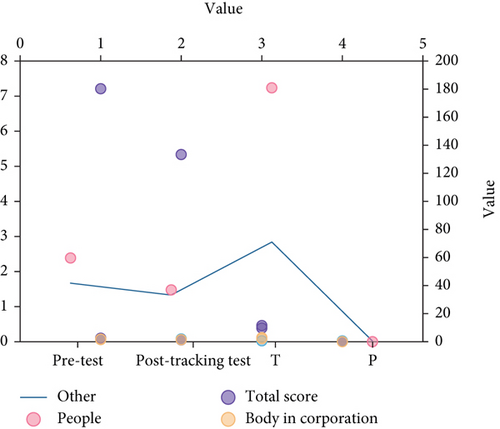
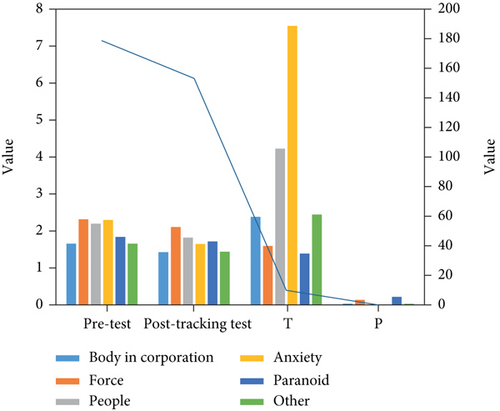
| Item | Pretest | Posttest | T | P |
|---|---|---|---|---|
| Somatization | 1.56 ± 0.33 | 1.66 ± 0.27 | -1.569 | 0.148 |
| Force | 2.32 ± 0.42 | 2.24 ± 0.29 | 0.877 | 0.401 |
| People | 2.47 ± 0.52 | 2.58 ± 0.48 | -1.305 | 0.221 |
| Anxiety | 2.40 ± 0.33 | 2.25 ± 0.52 | 0.870 | 0.404 |
| Paranoid | 2.12 ± 0.61 | 1.95 ± 0.41 | 1.300 | 0.223 |
| Other | 1.73 ± 0.41 | 1.90 ± 0.22 | -1.695 | 0.121 |
| Total score | 186.27 ± 13.53 | 182.91 ± 12.50 | 1.273 | 0.232 |
From the statistical results in Figure 13, it can be seen that there are extremely significant differences in the total score, anxiety, and interpersonal factors of the experimental group B tracking test compared with the previous test (P < 0.01), and the somatization and other factors also reached significant difference which was found, but there was no significant difference in the three factors of compulsion and paranoia (P > 0.05). In general, it shows that after two months, the experimental group B also maintained a good treatment effect.
It can be seen from the statistical results in Table 8 that the statistical results of the control group show that there is no significant difference in the changes in the factors and total scores of the test subjects before the experiment and after the tracking (P > 0.05).
- (1)
The intervention has a solid theoretical foundation, and the forms and methods of intervention are realistic. The experimenter can appropriately use cognitive and behavioral therapies based on previous theories, design reasonable group activities, and focus on the reconstruction of students’ thinking and the cultivation of reasonable behavior habits, through games and role-playing in the group. Students are exposed to real situations and consolidate what they have learned through homework, so that they can build a reasonable and positive self-recognition system and behavior habits
- (2)
The group provides them with opportunities to communicate, vent, learn, and practice. The group provided the subjects with a relaxed, open, and free activity scene. The group is sufficiently safe and supportive for the students. Here, each group member can express his thoughts and emotions equally and sincerely. Behavior, here, every member of the group can feel everyone’s warmth, understanding, and support
5. Conclusion
- (1)
It is a common phenomenon that college students in China are weak in English translation ability, and very few college students have strong English translation ability. The reasons for the weak English translation ability of college students mainly include the low attention of teachers, the lack of translation skills, and the weak foundation of knowledge
- (2)
Most students have a certain degree of psychological barriers to English learning, which are caused by many factors, including unscientific learning methods, lack of learning confidence, poor self-control, language barriers, and teaching mistakes
- (3)
There is a close relationship between college students’ English translation ability and their psychological disorder
Conflicts of Interest
The author declares that they have no conflicts of interest.
Open Research
Data Availability
This article does not cover data research. No data were used to support this study.




